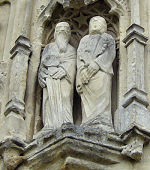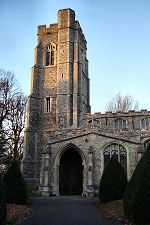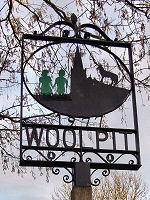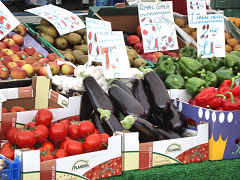Suffolk Villages Around Bury St Edmunds
A guide to some of the local villages and attractions within reach of Bury St Edmunds
Cavendish and Clare

The Cavendish Village Sign
Approximately 18 miles from Bury St Edmunds, Cavendish and Clare can both be toured within a couple of hours.
Though Cavendish is now a charming, peaceful village, the village sign depicts the killing of Wat Tyler, leader of the Peasant's Revolt, in 1381 by the son of Sir John Cavendish, then Chief Justice of the Kings Bench.

The Pink Houses and Church, Cavendish
The local populace pursued Sir John for revenge, who attempted to escape by hanging on to the door handle of St Mary's Church, pleading sanctuary.
His pleas unsuccessful, he was taken to Bury St Edmunds and there beheaded by the mob.

An example of pargeting, Cavendish
From the top of the gently sloping village green, visitors can enjoy the well known local view of the pink cottages at the foot of the green, with St Mary's Church rising behind.

The Village Green, Cavendish
Decorative pargeting, some painted, can been seen adorning the outer plaster on many of the houses around the village. Behind the main street, the Sue Ryder Foundation Museum contains World War II memorabilia and a history of the charity and its founder, Sue Ryder, who is buried in Cavendish.
A couple of miles away lies the equally picturesque village of Clare, where some of the finest remaining examples of ornamental pargeting can be seen. Wealthy clothiers and merchants liked to add these painted plaster reliefs to the exterior of their houses to openly flaunt their wealth.

Pargeting, Clare
Amongst the other attractions Clare has to offer are the Parish Church of St Peter and St Paul, Clare Priory and the Ancient House Museum which maintains a town trail. In Clare Castle Country Park, visitors can see remains of the thirteenth century castle keep, along with part of the Inner Bailey Wall, as well Clare's abandoned station house and platform built in 1865.
Lavenham

Lavenham's Village Sign
Approximately 12 miles from Bury St Edmunds, it is easy to spend half a day in Lavenham touring the town, visiting the Guildhall of Corpus Christi and browsing the shops.
Lavenham is a peaceful little town brimming with medieval charm and crooked historic timber-framed buildings. Its fortunes rose and fell with the success and decline of England's cloth industry.

Water Street, Lavenham
By 1524, it was the fourteenth richest town in England, and boasted four guildhalls. Many of the original wealthy clothiers' houses still remain with evidence of their large ground level doorways which were designed to be used with hoists to load wool, yarn and cloth.

The Swan Hotel, Lavenham
A picturesque row of brightly coloured houses can be found on Water street, so named because a stream once ran there which was used for dyeing and fulling. Round the corner from these, in Barn street, is Mollet house, another fine example of a prosperous clothiers house.
Our Lady's Guildhall, built in 1464, was entirely dismantled and transported to Ascot in 1911, but this caused such a furore that it was returned in 1963 and now forms part of the expansive Swan Hotel.

The Guildhall of Corpus Christi
In the centre of town, the Market Place is dominated by the striking Guildhall of Corpus Christi built in 1529. As well as serving as town guildhall, the building has over the years also seen use as a school, workhouse and prison.
Since 1950, it has been a National Trust museum documenting Suffolk's wool, cloth and horse-hair industries.

Little Hall, Lavenham
Dating back to the late fourteenth century, the more colourful Little Hall started life as a family home, and is now a museum housing the Gayer-Anderson collection of furniture, sculpture and ceramics, and also the headquarters of the Suffolk Preservation Society.

The Church of St Peter and St Paul
At the top of the hill, sits the magnificent Church of St Peter and St Paul, completed in 1525, shortly before the decline of Lavenham's wool industry.

St Peter and St Paul
The base of the tower is decorated with stars and shields, the keys of St Peter, and the swords of St Paul. Within are intricately carved wooden parclose screens.
Alongside the perfectly preserved medieval buildings, visitors to Lavenham can also enjoy a variety of quaint boutiques, antique and craft shops, pubs and tea rooms.
Long Melford
Approximately 14 miles from Bury St Edmunds, depending on the time of year you could spend a whole day in Long Melford visiting Kentwell Hall, Melford Hall and browsing the village's many antique shops.

The Church of the Holy Trinity
Long Melford began life as an important settlement at the point where five roman roads converged beside the river Stour. As with many nearby villages, it flourished along with Suffolk's prosperous wool and cloth industries. Its town centre consists of a three mile-long main street littered with antique shops, at the end of which lies an expansive village green which once hosted market fairs and medieval processions.

Hospice of the Holy and Undivided Trinity
At the very top of the village green is the Church of the Holy Trinity, which has seen much alteration and restoration since it was originally built in 1484 on the site of a much older church.
The fine Tudor redbrick building in front of the church is the Hospital of the Holy and Undivided Trinity, originally built as Almshouses in 1573 by William Cordell.
Kentwell Hall, which dates back some five hundred years, is a lovingly maintained and restored family home set in extensive grounds which include a working farm, rose garden, herb garden, maze, and woodland walks. It is perhaps most famous for the annual Tudor Re-Creations which take place there.

Melford Hall
Melford Hall was built by William Cordell in the sixteenth century, to provide a suitably lavish welcome for the royal visit of Queen Elizabeth I. Amongst the collections are an exhibition commemorating Beatrix Potter's visits to the house, and some fine Chinese porcelain captured from a Spanish Galleon in 1762.
During the winter months when both halls are closed to the public, Long Melford continues to attract tourists and collectors thanks to its plethora of antique shops. The long high street offers plenty of opportunities for light snacks, dining, or fine cuisine.
Pakenham

The Water Mill, Pakenham
Approximately 7 miles from Bury St Edmunds, touring Pakenham's Water Mill takes around an hour.
Pakenham's proud claim to fame, is to be the last remaining village in the country to have two working mills. Corn has been ground on this quiet river spot for over nine hundred years.

The Windmill, Pakenham
The Doomsday Book records the presence of a mill in 1086, and the current eighteenth century Water Mill is built on the remains of a Tudor one.
In 1978 The Suffolk Building Preservation Trust took over the Mill, which had stopped working commercially only four years earlier, and began the process of restoration and maintenance. The Mill is now a working exhibition, and its stone ground flour is sold on site and at the village shop.
At eighty feet tall, the Windmill is an impressive landmark on Suffolk's horizon. Built in 1830, it is now privately owned, but still turns its sails occasionally.
Risby

The Risby Barn
Approximately 4 miles from Bury St Edmunds, the Risby Barn Antiques Centre can be browsed in under an hour
The Risby Barn Antique Centre comprises five companies occupying a plot on the edge of the village, along with a cafe and free parking.
The main building is a striking fifteenth century thatched barn selling antiques and collectibles. Alongside it is the Dogwood Garden Centre, Brambles Forge, Roberts furniture manufacturers and restorers, and the Past & Present Antique Bric-a-Brac shop.
Sudbury
Approximately 18 miles from Bury St Edmunds, you can easily spend half a day in Sudbury visiting Gainsborough's house, the shops and the historic buildings
Sudbury is a historic market town on the River Stour dating back to Saxon times. It grew thanks to Suffolk's thriving medieval wool and cloth industry, then later continued to prosper by producing silks and velvets.

Salter's Hall, Sudbury
Many fine examples of medieval carved and timber-framed clothier's building still remain, such as Salter's Hall and The Chantry in Stour Street.
Down by the river bank, the former water mill is now an hotel, surrounded by water meadows grazed continuously since 1086.

The Thomas Gainsborough Statue
Sudbury's most famous son is the painter Thomas Gainsborough. His statue stands in the town's centre, and Gainsborough's House, where he was born in 1727, is now a museum housing many of his works and personal possessions.
Also overlooking the town's central triangular Market Hill is the distinctive white Tuscan-columned library, originally built in 1841 as Sudbury's Corn Exchange. Sudbury town centre has plenty of shops and boutiques, pubs and restaurants, as well as a popular market every Thursday and Saturday.

St Gregory's Church
Heading out of town along Gregory Street, St Gregory's is an imposing collegiate church with a chequered history.
Simon Theobald, also known as Simon of Sudbury, founded a College for priests here, before going on to be Archbishop of Canterbury and crowning King Richard II in 1377. Three years later, as Chancellor of England, Simon introduced the Poll Tax, a major contributing factor towards Wat Tyler's Peasant's Revolt of 1381. He was beheaded by an angry mob and, while his body is buried in Canterbury, his mummified head is preserved in a small locked alcove in the vestry of St Gregory's, and can be viewed by appointment. Also noteworthy is the magnificent fifteenth century font cover, and a sole surviving original rood screen panel depicting John Schorn casting the devil into a boot.
West Stow
Approximately 6 miles from Bury St Edmunds, the Anglo Saxon Village takes about an hour to explore. There is also a cafe and shop, and plenty of woodland walks in the surrounding Country Park.

The Pig House at West Stow
A chance discovery led to the original excavation at West Stow some forty years ago, which uncovered evidence of a Saxon settlement having occupied it from around AD 420 to 650. Enough remained to allow for a reconstruction of several buildings, using authentic tools and materials, which tourists are now able to visit.
West Stow holds several special events throughout the year, where visitors can watch Anglo Saxon re-enactors bring the village to life with demonstrations of crafts, clothing and cooking.
Woolpit

The Village Pump
Approximately 10 miles from Bury St Edmunds, visiting the museum and touring the village takes around an hour. Allow at least an hour to browse the Sunday Boot Fair.
Woolpit, named for its Saxon wolf-trapping pits, was for many centuries an exporter of durable bricks, known as 'Woolpit Whites', made from locally dug clay.

Carving of Queen Victoria
At the centre of Woolpit, triangular crossroads meet at the village pump, housed under a conical pavilion erected in 1897 to commemorate Queen Victoria's Diamond Jubilee. Each of its four wooden posts is decorated with a carving of a former Queen of England.

St Mary's Church
Surrounding the pump are local shops, pubs, and the Woolpit Bygones Museum. Run by volunteers, the museum houses a permanent display about Woolpit's brickmaking history, as well as other exhibits which change annually. Just across the road, the parish Church of St Mary is known for its 'Angel Roof' and pew carvings dating back to the fifteenth century.
The Beacon
Woolpit also has hidden history. To the north-east of the church, beside an ancient beacon, is the site of the historic Lady's Well, whose waters were said to cure eye afflictions. Infirm children were brought to be dipped in the waters, and medieval pilgrims would bathe their eyes in the well before visiting 'Our Lady of Woolpit', the Church's shrine to the Blessed Virgin Mary.

Woolpit Village Sign
Clearly depicted on the village sign are the legendary 'Green Children' of Woolpit. Sometime during the twelfth century, local farm workers were harvesting the fields when they heard desperate cries. They discovered two small children, a girl and a boy, with green skin and unfamiliar clothes, wailing in an unknown language. When offered food, the children refused everything but beans, which they ate hungrily.
The villagers took in the children, but the boy was weak and died. The girl, however, grew strong and eventually lost her green hue. She eventually learned to speak English and married a local man. According to legend, she was able to explain that they had come from a land named Saint Martin which was permanently in twilight, though she had no idea how they had arrived in Woolpit.

A Fruit Stall at the Car Boot Sale
There has been much speculation over the years as to the origins of the story, but no definitive answer has yet been found.
Every Sunday morning throughout the year, Woolpit hosts a large Car Boot Sale from 7am. It is located to the north-west of the village, close to the A14, parking is free.